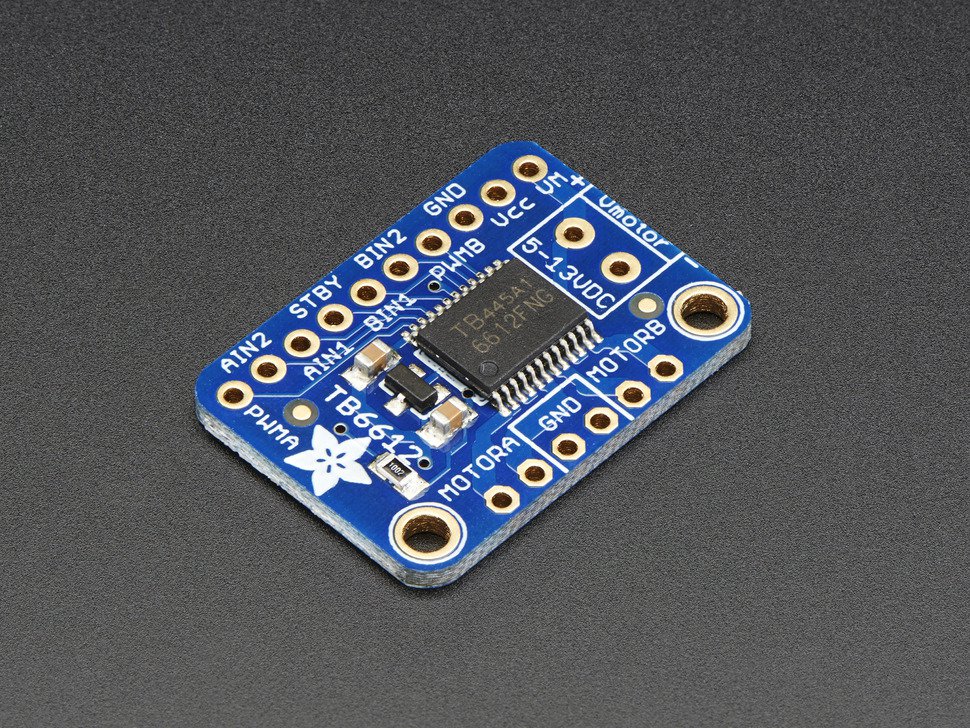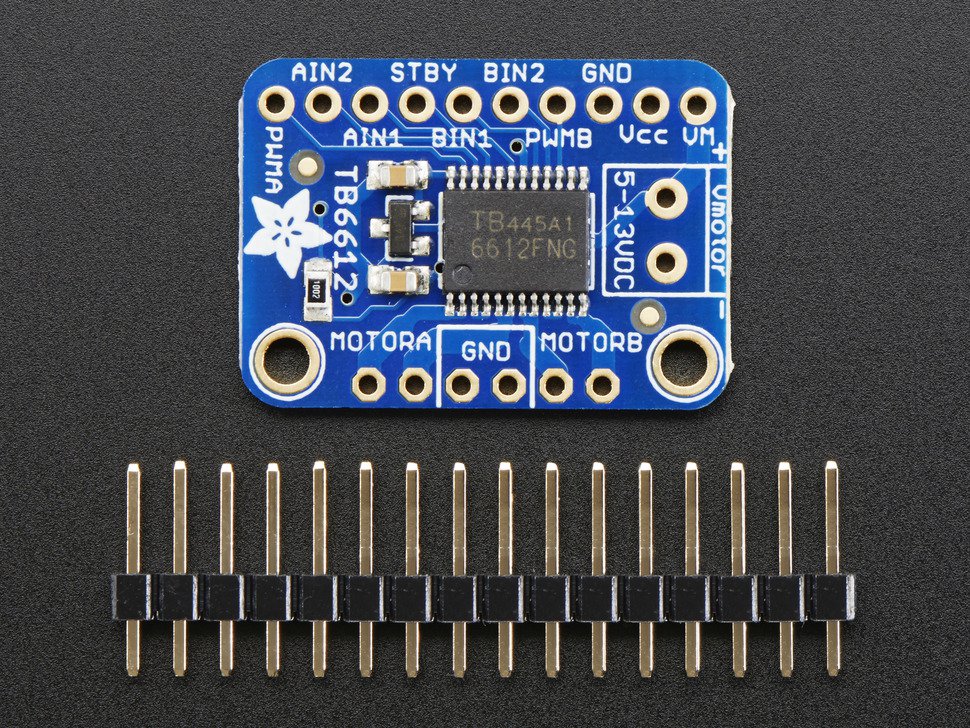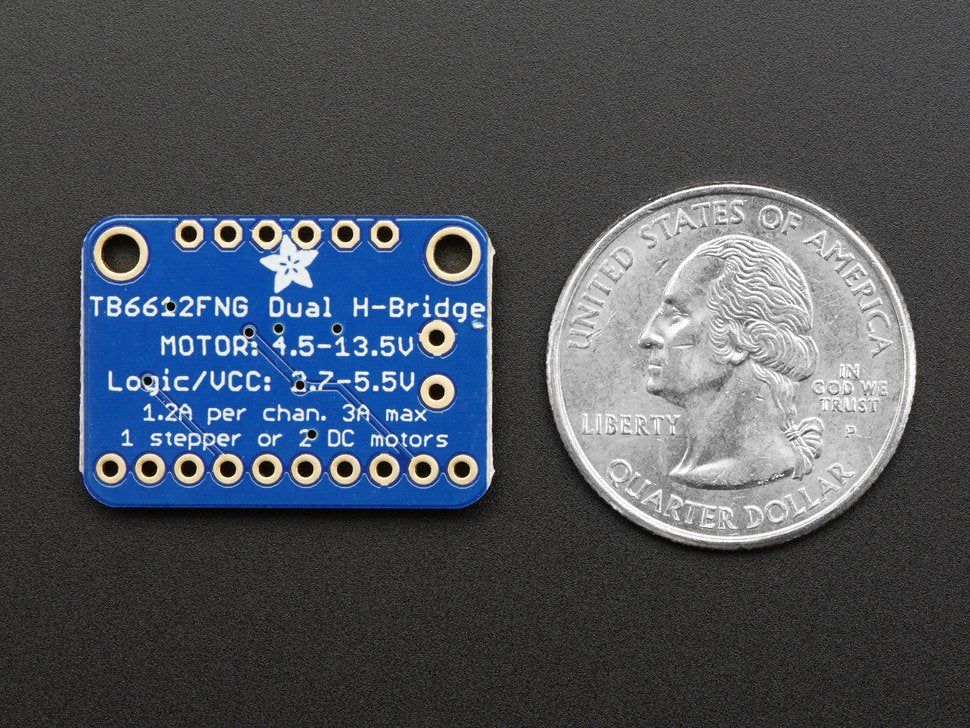DC / Stepper Motor Driver TB6612 1.2A Breakout Board Adafruit - Spin two DC motors, step one bi-polar or uni-polar stepper, or fire off two solenoids with 1.2A per channel using the TB6612. These are perhaps better known as "the drivers in our assembled Adafruit Motorshield or Motor HAT." We really like these dual H-bridges, so if you want to control motors without a shield or HAT these are easy to include on any solderless breadboard or perma-proto.
We solder on TB6612 onto a breakout board for you here, with a polarity protection FET on the motor voltage input and a pullup on the "standby" enable pin. Each breakout chip contains two full H-bridges (four half H-bridges). That means you can drive 2-4 solenoids (only two can be active at a time, on opposite bridges), two DC motors bi-directionally, or one stepper motor. Just make sure they're good for 1.2 Amp or less of current, since that's the limit of this chip. They do handle a peak of 3A but that's just for a short amount of time, like 20 milliseconds. What we like most about this particular driver is that it comes with built in kick-back diodes internally so you don't have to worry about the inductive kick damaging your project or driver!
There's two digital inputs per H-bridge (one for each half of the bridge) as well as a PWM input per driver so you can control motor speed. Runs at 2.7V-5V logic. The motor voltage is separate from the logic voltage. Good for motor voltages from 4.5V up to 13.5V! This wont work well for 3V motors.
Comes as one assembled and tested breakout plus a small strip of header. You'll need to do some light soldering to attach the header onto the breakout PCB. Arduino, motors, and power supply not included. Check out our handy tutorial on assembly and wiring!
Selecting the Right Motor Driver
Before we begin, let's discuss how to discover a motor driver who meets your requirements.
- Finding out what kind of motors you are using and researching their specifications should be your first step. It is not beneficial to select a motor driver for a weak motor. Additionally, keep in mind that there are various motor kinds (stepper, DC, brushless), so be sure to hunt for the right kind of motor driver.
- Make sure your motor driver's current and voltage ranges are suitable for your motor by checking its specifications (s).
- To begin with, you must confirm that your motor driver is capable of handling the rated voltage of your motors. Although you can normally operate motors a little bit above their ratings, it usually shortens the motor's lifespan.
- The second element is the current draw. Your motor driver must be able to handle the amount of current that your motors will draw. Always start with the motor's stalled current number as a general rule (the current draw is present when you are holding the motor still). When a motor stalls, it will draw the most current. This is a secure number to use even if you don't intend to cause your motor to stall during your project.
- It is time to replace your motor driver if it cannot manage that amount of current (or motor). You may have also noticed that motor drivers frequently state their maximum continuous current and maximum peak current. Depending on your application and the amount of stress your motor will experience, these specifications are important to note.
- This manual covers the TB6612FNG motor driver, which is compatible with the majority of our DC motors and has a supply voltage range of 2.5V to 13.5V and a peak current capacity of 3.2A (per channel). If the TB6612FNG does not meet the requirements of your project, view our assortment of different motor driver boards.
- As with any board, there are additional factors to take into account, such as heat dissipation and the logic voltage, which is essentially the voltage used to communicate with your microcontroller. Although these issues must be taken into account, they can be addressed with tools like level shifters and heat sinks. However, there isn't much you can do to fix it if your motor is attempting to draw more current than your driver can support.
TECHNICAL DETAILS
- Current Limit: 1.2A
- Size: 27mm x 19mm x 3mm / 1.1" x 0.7" x 0.1"
- Weight: 1.8g
-
Datasheets, EagleCAD PCB files, and Fritzing object available in the product tutorial
DC / Stepper Motor Driver TB6612 1.2A Breakout Board Adafruit
DC / Stepper Motor Driver TB6612 1.2A Breakout Board Adafruit
Low stock: 2 left
Product Code
SKU:2448
Couldn't load pickup availability








